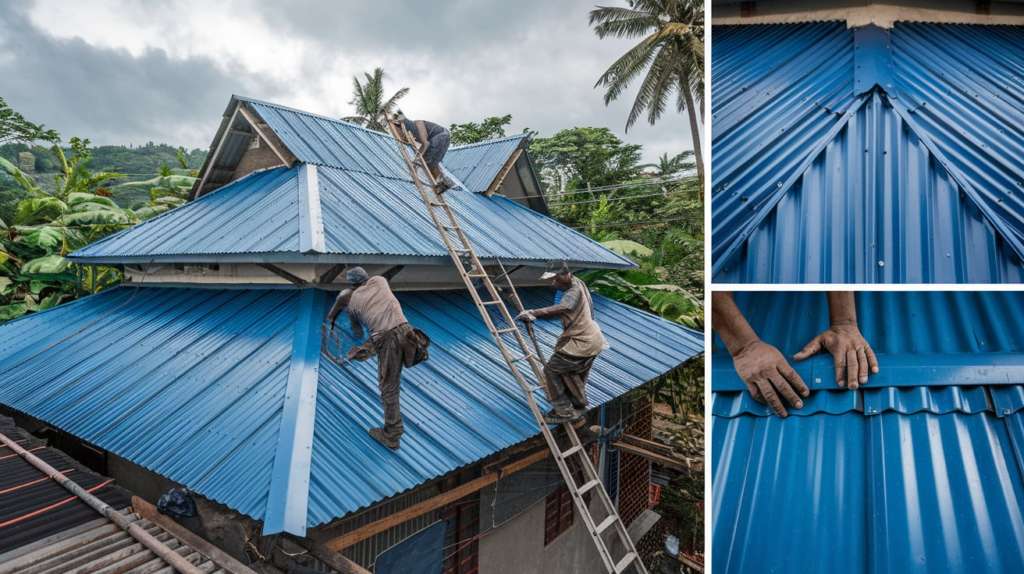Metal roofing is a top choice for Filipino homeowners because of its durability, lightweight nature, and ability to withstand the country’s tropical weather. Whether it’s typhoon season or the intense heat of summer, metal roofing offers reliable protection for your home.
However, even the toughest roofs need repairs over time. Factors like rust, leaks, dents, or loose fasteners can affect the integrity of your metal roofing. The good news? Most metal roofing repairs are manageable if you follow the right steps and use proper materials.
This guide will provide you with a step-by-step approach to fixing common metal roofing problems, ensuring your roof remains sturdy and leak-free.
Common Problems with Metal Roofing
Understanding the common issues with metal roofs can help you address them before they escalate:
1. Rust and Corrosion
• Occurs when the protective coating wears off.
• Common in older roofs or those exposed to saltwater in coastal areas.
2. Leaks and Water Damage
• Can result from loose or missing fasteners, damaged seams, or punctures.
3. Loose Panels or Fasteners
• High winds and normal wear and tear can cause screws or nails to loosen.
4. Dents and Scratches
• Hail, falling debris, or heavy impacts can dent or scratch the roof surface.
5. Seam Separation
• Expansion and contraction of metal can cause seams to pull apart, creating gaps.
6. Noise
• Poor insulation or loose panels can result in noisy roofs during heavy rains.

Tools and Materials for Metal Roofing Repair
Tools
• Hammer or drill
• Roofing nails or screws
• Metal cutter or tin snips
• Pry bar
• Ladder or scaffolding
• Safety gear (helmet, gloves, harness)
Materials
• Roofing sealant or adhesive
• Replacement metal panels or patches
• Waterproof underlayment
• Rust remover and metal primer
• Silicone caulking
• Paint for metal roofs (optional)
Step-by-Step Metal Roofing Repair Guide
Follow these steps to repair your metal roofing effectively:
Step 1: Inspect the Roof
• Look for visible signs of damage, such as rust spots, cracks, or loose panels.
• Check for water stains or leaks inside your home to identify potential problem areas.
• Use binoculars for a preliminary check or climb up safely using a ladder.
Step 2: Clean the Roof Surface
• Remove dirt, debris, and moss from the damaged area using a brush or soft cloth.
• For rusted areas, use a wire brush or sandpaper to remove rust.
• Apply a metal primer to prevent further corrosion.
Step 3: Fix Leaks and Punctures
• Small Leaks or Holes:
• Apply a roofing sealant or silicone caulking to seal the puncture.
• Smooth the sealant with a putty knife to ensure full coverage.
• Large Holes or Cracks:
• Cut a metal patch slightly larger than the damaged area.
• Attach the patch using roofing screws and seal the edges with roofing adhesive.
Step 4: Replace Damaged Panels or Sections
• Use a metal cutter to remove the damaged panel.
• Install a new metal panel, ensuring it overlaps the surrounding panels for a watertight seal.
• Secure the new panel with screws or nails, using rubber washers to prevent leaks.
Step 5: Tighten Loose Fasteners
• Inspect screws and nails across the roof. Tighten any loose fasteners to secure the panels.
• Replace missing screws or nails with new ones that match the roof material.
Step 6: Seal Seams and Edges
• Apply silicone caulking or a high-quality roofing sealant along seams, edges, and around fasteners.
• This will prevent water from seeping under the metal panels.
Step 7: Repaint or Coat the Roof
• If needed, repaint the repaired area with a metal roof paint to restore its appearance and add a protective layer.
Cost of Metal Roofing Repairs in the Philippines
Here’s an estimate of the costs for common metal roofing repairs:
Fixing Small Leaks or Holes: PHP 500 – PHP 1,500 including sealant and labor.
Replacing Damaged Panels: PHP 2,000 – PHP 5,000 per panel depending on material and size.
Repainting the Roof: PHP 50 – PHP 100 per sqm including paint and labor.
Full Roof Inspection: PHP 500 – PHP 1,000 but cost varies by location and contractor.
Note: Prices vary depending on the extent of damage, location, and labor costs.
Tips for Maintaining Metal Roofing
To minimize the need for frequent repairs, follow these maintenance tips:
1. Inspect Regularly: Check your roof at least twice a year and after typhoons for signs of damage.
2. Clean Debris: Remove leaves, dirt, and branches to prevent rust and water pooling.
3. Recoat Periodically: Apply a fresh coat of protective paint or sealant every 5-10 years.
4. Tighten Fasteners: Check screws and nails to ensure they remain secure.
5. Prevent Rust: Use a rust remover and metal primer to treat small rust spots before they spread.
6. Hire Professionals for Major Repairs: For large-scale repairs or structural issues, consult a roofing contractor.
When to Call a Professional
While many metal roofing repairs can be handled DIY, some situations require professional expertise:
• Extensive Damage: Large leaks, structural issues, or widespread corrosion may need a contractor’s skills.
• Safety Concerns: If the roof is steep or difficult to access, leave the repair to trained professionals.
• Warranty Coverage: Some roofing warranties require repairs to be done by licensed professionals to remain valid.
Why Metal Roofing Repair Is Worth It
Regular maintenance and timely repairs can extend the lifespan of your metal roofing by decades. Here’s why it’s worth the effort:
• Prevents Costly Replacements: Addressing minor issues early can save you from replacing the entire roof.
• Protects Your Home: A well-maintained roof keeps your home safe from leaks, mold, and structural damage.
• Preserves Aesthetic Appeal: Repairs keep your roof looking new and well-kept, enhancing your home’s curb appeal.
Conclusion: Keep Your Metal Roofing in Top Condition
Metal roofing is a durable and reliable choice for Filipino homes, but regular maintenance and timely repairs are essential to maximize its lifespan. Whether you’re fixing small leaks, replacing panels, or sealing seams, following this guide will help you maintain a strong and sturdy roof.
To recap:
• Inspect your roof regularly and address issues like rust, leaks, or loose fasteners promptly.
• Use high-quality materials for repairs to ensure long-lasting results.
• Consult professionals for extensive damage or complex repairs.

Need expert help with metal roofing repairs? Contact our trusted Filipino roofing specialists today! We’ll ensure your roof is restored efficiently and professionally.
